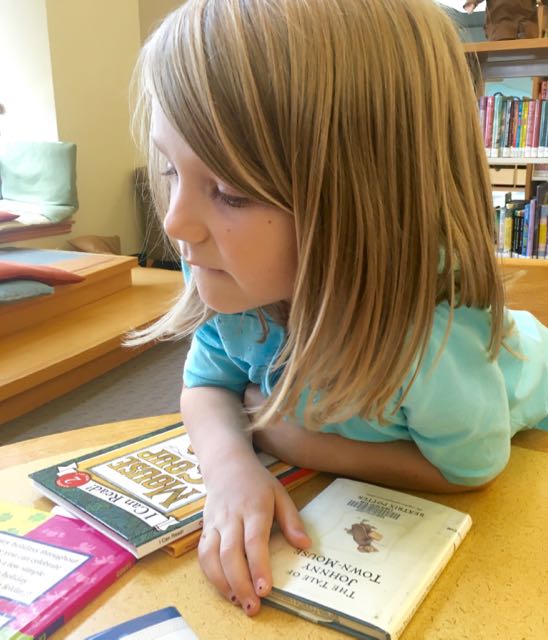I am not an expert. I am not even trained for early childhood education. I make no claims of expertise. I am just a mom who is a voracious reader and who will do anything reasonable under the sun to make sure that her kids have the right relationship with reading. A reading relationship built on love, excitement, confidence, and good phonetic foundation. What little I do know about reading is this: phonics is almost essential for long-term reading potential.
The trouble is that I didn’t learn phonics or grammar very well as a child and I caught most of the goodness just through reading, reading, reading. That is both a blessing and a curse. The blessing it is that I read widely, deeply, and reasonably well. The curse is that I have a lot of bad habits and very little understanding of how to share what I know. How in the world could I teach my children to read!? Unlike Diane, I don’t “get it”.
When my oldest was coming into the age of reading possibilities, I knew that I needed a phonics program but I didn’t know what. Like everybody I know, I bought a copy of Teach Your Child To Read in 100 Easy Lessons. In addition to 100 Easy Lessons, I bought four box kits of the Bob Books readers, the Mott Media old fashioned McGuffey readers, and I downloaded the free “Progressive Phonics” books. It took Michael a long time to learn to read – longer than most homeschool moms are comfortable with, but with a solid phonics foundation, it became very intuitive once it clicked.
My second reader learned differently. For Greta, Bob Books and the Mott Media McGuffey readers were magic. She did very well learning the basics of phonics. I supplemented again with some LeapFrog phonics videos and Between The Lions because she likes knowing the phonics rules and both of those programs teach them really well.
Unlike her brother, it was easy to learn but never became intuitive. Greta must learn things through repetition and she needs someone or something to patiently practice with her. I am not patient and I have several children to homeschool. This was proving very hard for me and for her. Then it hit me. Many of the classic story readers like Frog and Toad or any of the Arnold Lobel classics also have audiobook companions. Greta did not need me to practice with her, she just needed something easy to control that would remind her of sounds when she was stuck.
This summer, I purchased a stack of Level 2 Readers from children’s classics like the Frog and Toad books, Owl At Home, Grasshopper On The Road, and Uncle Elephant. I got what she liked. That was the magic, if she had liked Frances or Uncle Wiggly, I would have bought those. And then, I bought the audiobooks to go with them. (She has since moved on to the Beatrix Potter collection and the Thornton Burgess books – also paired with audiobooks.)
Every day, for at least half an hour (during her prescribed reading time), she sits with the Audible app on a Kindle Fire and plays whichever story she is working on. She also sits with the printed reader and reads the page to herself. Then, she plays that page worth of narration to test her performance. After listening (and following with her eyes), she goes back and rereads the page, correcting her errors. She repeats this process page by page in the reader. Usually it takes her about three days to really get a book learned.
Initially, I was worried that she was just memorizing the words, which would defeat the point of teaching phonics. I did not want her to memorize the stories, I wanted her to recognize the words and be confident about which sounds they make and what they mean. After a week or so, I tested her ability. I gave her other books at a similar level to read aloud to me. Without question, her vocabulary was growing and her ability to sound out words was improving. For her learning style, having an audiobook to practice with has saved us so many tears!
This is one of my favorite things about homeschooling. My first and second readers have totally different learning styles. While it is a lot of discerning work for me to figure out what they need, the principles remain the same: phonics, patience, and relationship. In each case, the principle of phonetic reading remained the standard foundation. In each case I had to show my child patience while we discerned their path through the learning-to-read process. And finally, in each case the principle of nurturing their love of the written word had to govern any choices we made.

Great tip for simplifying a process that already stresses me out (I, like you, don’t “get it.”)
Yay! I hope that it helps, Heidi! There is little in homeschooling that I loathe as much as the teaching the mechanics of reading. Anything that can support that effort is a win for me! -Sara
Discernment–yes!
“One of the main concerns of those who instruct others is to be able to understand their students and to discern the right way to guide them. There are those who call for much patience, those who need to be stimulated and spurred on . . . This guidance requires understanding and discernment of spirits, qualities you should frequently and earnestly ask of God, for they are necessary for you in the guidance of those placed in your care. “
St. John Baptist de La Salle
Yes! Amen! St. John Baptist de La Salle, pray for us! Live Jesus In Our Hearts, Forever!